Contents
Market Overview
Macro Update
Amid the scarcity of official U.S. macro data due to the continuing government shutdown, investors have increasingly been turning to alternative data sources from the private sector, some of which seemed this week to indicate a cooling labor market. Meanwhile, concerns over a potential artificial-intelligence (AI) bubble also mounted, weighing on global equity and crypto valuations.
Against this backdrop, it was a risk-off week for U.S. equities, while Treasuries reversed earlier losses, supported by revived market expectations of a December Fed rate cut. The tech-heavy NASDAQ led the decline, sliding around 4%, its worst week since the April tariff-fueled tantrum. The 10-year U.S. Treasury yield finished the week around 4.10%, having broken through 4.15% earlier – around 20 bps higher than late October levels. The 30-year yield finished the week around 4.70%. The dollar looked as though it would break through 100 on the DXY for the first time since May, but it ultimately gave back gains with the reversal of hawkish Fed sentiment – and ended the week below the 100 DXY mark.
Oil prices trended lower this week, with Brent in the low-$60s and WTI back in the high $50s. There were concerns about oversupply following the OPEC+ production meeting and Saudi Arabia’s move to lower the price of its main oil grade to Asia for December to the lowest level in 11 months. Gold also gave up some of its spectacular year-to-date gains, easing to just below $4,000 per ounce.
The week also produced important developments in U.S. politics. In a highly anticipated hearing, the Supreme Court began deliberations over the legality of some of President Donald Trump’s trade tariffs that the White House had authorized without Congressional approval by invoking an emergency economic-powers law. A final decision will likely take at least a few weeks, and the Trump administration has other options for keeping tariffs in place. Any potential “refunds” of collected tariff revenue would weigh heavily on the U.S. fiscal outlook.
In the world of global monetary policy, the Bank of England (BoE) held rates at 4%, as expected, in a split 5-4 vote. The central bank’s accompanying communication suggested that the BoE seems ready to restart cutting rates in early 2026, earlier than previously anticipated. The UK government budget, which is likely to call for tighter fiscal policy, is due to be presented in late November and could reinforce the case for monetary easing. The Reserve Bank of Australia (RBA) also kept its policy rate unchanged (3.60%), keeping the door open for 2026 rate cuts. Across emerging markets, central banks in Brazil (15.0%), Czechia (3.50%), and Malaysia (2.75%) held rates steady, while those in Poland and Mexico cut by 25 bps, to 4.25% and 7.25%, respectively, in line with market expectations.
In the global macro data universe, final October PMIs across the euro area confirmed marginally better-than-expected economic activity. Similar trends were observed in the UK, as well as in India. In another constructive sign, German factory orders rose for the first time in five months (1.1% in September vs. 0.9% expected), supporting hopes for a turnaround in Europe’s largest economy after two years of contraction. Meanwhile, industrial production rose 1.3% month-over-month in September but underperformed the market median estimate of 3.0%. A 12.3% jump in automotive manufacturing underpinned the monthly gain, coming back from a decline in August. September retail sales in the euro area were stronger than expected on an annual basis (1.0% vs. 0.9%) but missed estimates on a monthly basis (-0.1% vs. 0.2%).
In the U.S., macro data remains scarce amid the ongoing federal government shutdown. The October ISM Manufacturing PMI was subdued at 48.7, down from 49.1 in September. However, the ISM Services index rose to 52.4 from 50.0 in September, expanding at the fastest pace in eight months, likely supported by the AI boom. Notably, the rebound in demand was also accompanied by more pronounced inflationary pressures as the Prices Paid index rose to 70, its highest level since 2022, indicating that the services economy is bearing the brunt of higher U.S. import tariffs. The preliminary November University of Michigan consumer sentiment index fell to 50.3, its lowest level since June 2022, underperforming the median market estimate of 53, as the government shutdown weighed on the economic outlook and high prices soured views about personal finances. Sentiment about “current conditions” fell to an all-time low.
EM Credit Update
Emerging Markets (EM) fixed income gave back some recent gains this week amid a broader risk-off tone across global fixed income markets. EM hard-currency sovereign bonds declined 0.34%, with investment-grade and high-yield segments posting similar performance. At the index level, spreads widened by 8 bps, reflecting a 10 bps widening in high yield and 6 bps in investment grade. Regionally, Africa underperformed, led by weakness in Angola, Zambia, and Côte d’Ivoire as sentiment deteriorated alongside broader risk aversion. Latin America also lagged, driven primarily by Venezuela, where the prior week’s enthusiasm over potential U.S. policy shifts and prospects for regime change subsided. Interestingly, typically higher-beta names in the region – Bolivia, Ecuador, and Argentina – posted positive returns, continuing to benefit from the recent Argentina rally and renewed political optimism. In the Middle East, speculative optimism around reforms and IMF engagement supported Lebanon, which outperformed on the week.
EM corporates were largely unchanged, returning -0.05%, with high yield (-0.07%) modestly underperforming investment grade (-0.04%). Spreads widened by 4 bps overall, with only marginal differentiation between rating segments. Eastern European corporates outperformed, particularly in Poland and Georgia, while Latin America underperformed on broad-based weakness. This excluded Argentina, where sentiment remains buoyant post-election, and Jamaica, which saw resilience after Hurricane Melissa’s damage proved less severe than feared. As expected, C-rated credits underperformed, while investment grade led relative performance.
Local-currency debt was little changed, returning 0.02%. Colombia (+2.1%) and Brazil (+0.9%) outperformed amid reassuring messaging on credible monetary policy management by their central banks, while Indonesia and Mexico both underperformed (-0.7%). In Indonesia, inflation surprised to the upside, weighing on rates, while lower copper prices posed a headwind to the Indonesian Rupiah. In Mexico, a worse-than-expected contraction in investment and security-related headlines contributed to underperformance.
Primary issuance remained active, with 24 new hard-currency deals roughly balanced between investment grade and high yield. Sovereign issuance was notable from Qatar, Jordan, Nigeria, China, and Brazil. Laos also tapped the market, an impressive feat given the prevailing risk-off backdrop. Regionally, issuance was concentrated in CEEMEA (50% of total), followed by Asia (30%) and Latin America (20%).
The Week Ahead
It will be a short week as many countries commemorate the end of World War I, with markets closed on Tuesday and the U.S. observing Veterans Day. There is likely to be increasing focus on the U.S. government shutdown, now the longest on record, amid more disruptions to daily life, especially air travel. COP30, the UN Climate Change Conference, will be in Brazil; however, many heads of state and other high ranking officials will not attend the annual event. Amid the scarcity of U.S. macro data, investors will hear from Treasury Secretary Scott Bessent at the U.S. Treasury Market Conference at the New York Fed and from White House National Economic Council Director Kevin Hassett at the Economic Club of Washington. Elsewhere, South African Finance Minister Enoch Godongwana will deliver the medium-term budget policy statement and OPEC will publish its monthly oil market report.
In China, the annual Singles’ Day shopping festival will take place, featuring deeply discounted offers from e-commerce giants. Chinese macro data includes October PPI and CPI, property prices, retail sales, and industrial production. The UK reports preliminary 3Q GDP, which may show modest growth, a potential boost for Chancellor of the Exchequer Rachel Reeves ahead of a challenging budget on Nov. 26. Other UK data include jobless claims, unemployment, and industrial production. Across the channel in Europe, markets will see the second reading of 3Q euro area GDP and Germany’s ZEW survey expectations, as well as German and French final October inflation. October CPI will also be released in Argentina, India, Poland, Colombia, Brazil, and Saudi Arabia. Policy rate decisions are due by central banks in Romania, Serbia, and Peru. Türkiye reports its September current account balance and Malaysia its final 3Q GDP. There will also be another heavy round of corporate earnings, with companies such as Disney and Tencent reporting.
Fixed Income
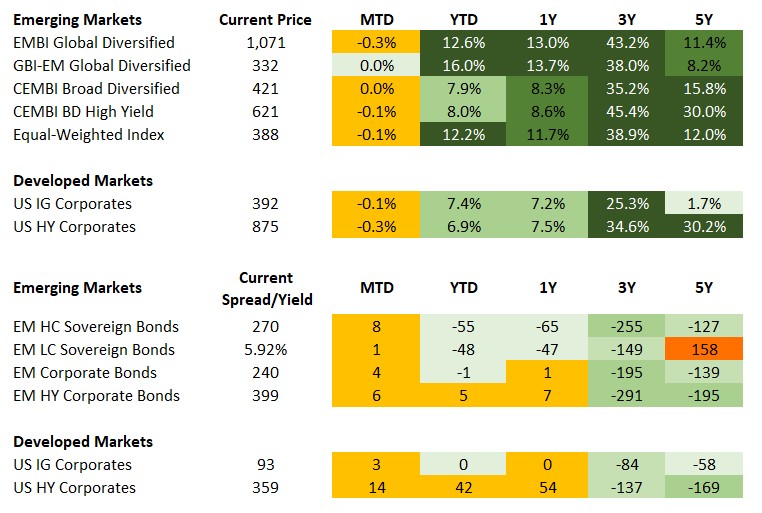
Equities
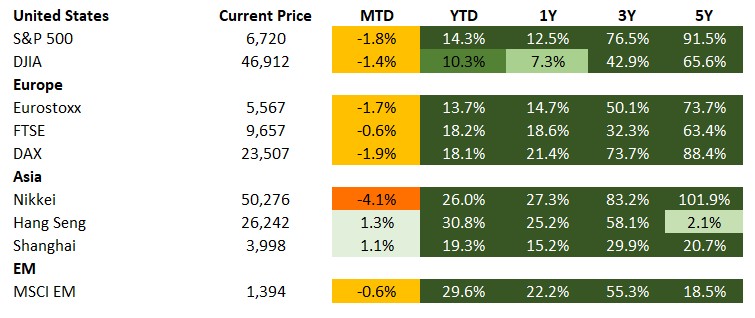
Commodities

Source for data tables: Bloomberg, JPMorgan, Gramercy. EM Fixed Income is represented by the following JPMorgan Indicies: EMBI Global, GBI-EM Global Diversified, CEMBI Broad Diversified and CEMBI Broad High Yield. DM Fixed Income is represented by the JPMorgan JULI Total Return Index and Domestic High Yield Index. Fixed Income, Equity and Commodity data is as of Nov. 7, 2025 (mid-day).
Highlights
Israeli Action in Lebanon to Disarm Hezbollah Appears Likely
Event: Amid futile attempts by authorities in Beirut to disarm Hezbollah, and despite diplomatic pressure to do so by both the United States and Israel, a new escalatory phase in the Israel–Hezbollah conflict now appears likely. This would end the cease-fire that has been in place since November 2024.
Gramercy Comment: Israel has indicated it will resume the war against Hezbollah by launching a large-scale military campaign into Lebanon that may involve air and drone strikes deep inside Lebanese territory, including against Hezbollah targets in Beirut. If Hezbollah’s complete disarmament is the ultimate objective, ground incursions across the border into Lebanon are also likely to be part of the operation and could target destroying Hezbollah’s presence in the whole of Lebanon – not just south of the Litani River near the Israeli border.
Renewed conflict with Israel could have a significant, short-term, and negative impact on Lebanese domestic political dynamics, which have otherwise trended in a constructive direction over the last year. A renewed campaign could further delay financial reforms such as the so-called “Gap Law,” which was designed to allocate banking sector losses and is a critical precondition for restarting Lebanon’s stalled discussions with the IMF. It could also lead to the postponement of Parliamentary elections that are scheduled for May 2026.
We are of the view that the sovereign bonds complex, having rallied substantially from a low base in 2025 on optimism about Lebanon’s political and economic prospects, has yet to price in these challenges and might face renewed downside pressure in the near-term.
Mexico’s Growth Picture Remains Mixed as Rate Cuts Continue
Event: Mexico’s domestic demand data for August reflected a continued divergence of investment and consumption, with the former contracting more than expected at 10.4% year-over-year. Private consumption showed greater resilience, posting a 0.1% gain year-over-year vs. consensus estimates of a 0.8% year-over-year decline. Workers’ remittances declined 2.7% in September compared to the year prior and were down 5.3% year-over-year in 3Q. Mexico’s central bank cut its policy rate by another 25 bps in response. The Lower House approved the 2026 budget, which calls for consolidation in the fiscal deficit to 4.1% of GDP, and approved the delay of tariffs on non-FTA countries until August 2027. At the same time, another assassination of a mayor prompted President Claudia Sheinbaum to launch a fresh plan to tackle violence. Meanwhile, U.S. attention on local security dynamics persists.e to 55%, a strong level in the historical context of Ecuadorian presidents at this stage of their mandates.
Gramercy Comment: Unsurprisingly, Mexico’s economy has slowed relative to last year amid headwinds to investment from domestic and external policy uncertainty, lower government spending, and softer U.S. activity. While the deeply negative investment data underscores a pocket of fragility, growth has not been as weak as was feared earlier this year. Consensus real GDP growth for 2025 sits around 0.5%, while a pick-up to 1.3% is penciled in for next year. The move to delay tariff imposition on non-FTA countries is positive from a macroeconomic standpoint, particularly given that inflation is set to pick up in 1Q26. This also affords authorities additional leverage heading into USMCA talks. We expect the security situation to remain fluid, with continued cooperation with the U.S. and avoidance of redlines.
Emerging Markets Technicals
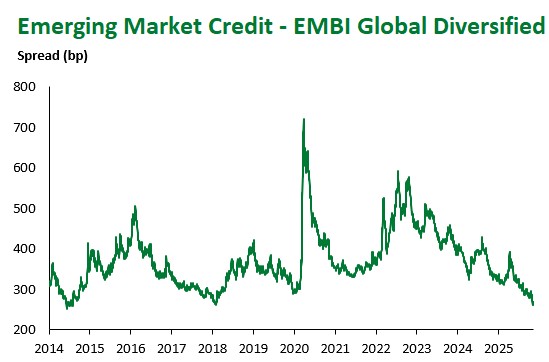

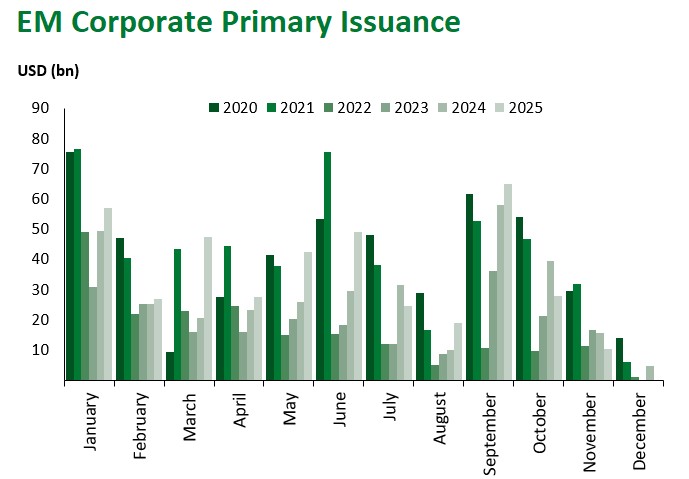
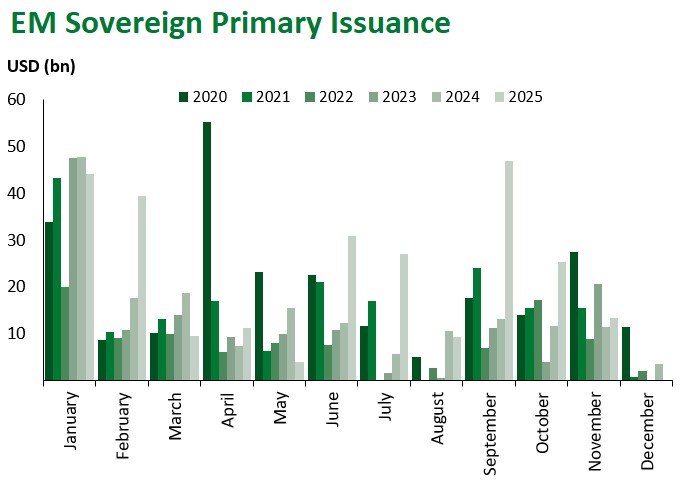
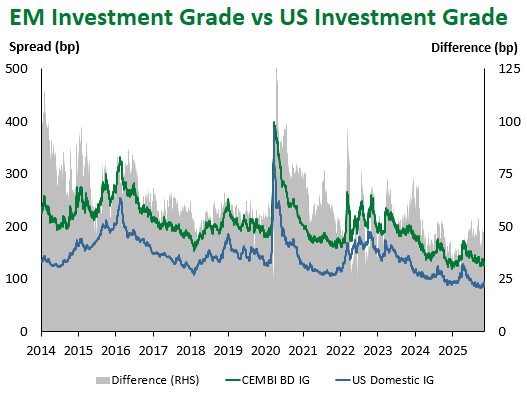

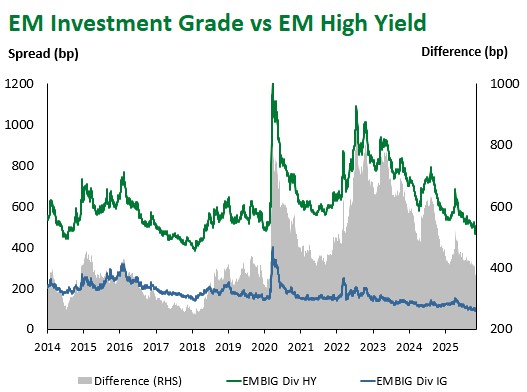
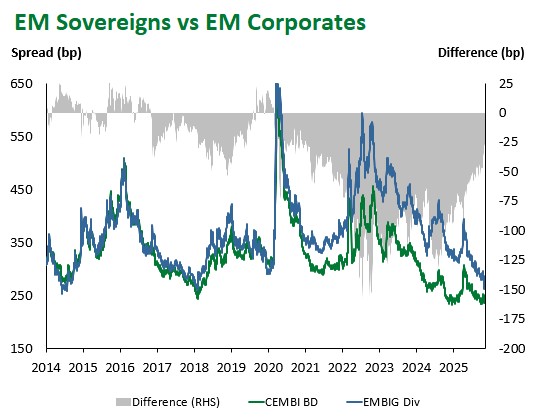
Emerging Markets Flows


Source for graphs: Bloomberg, JPMorgan, Gramercy. As of Nov. 7, 2025.
For questions, please contact:
Kathryn Exum, CFA ESG, Director, Co-Head of Sovereign Research, [email protected]
Petar Atanasov, Director, Co-Head of Sovereign Research, [email protected]
This document is for informational purposes only. The information presented is not intended to be relied upon as a forecast, research or investment advice, and is not a recommendation, offer or solicitation to buy or sell any securities or to adopt any investment strategy. Gramercy may have current investment positions in the securities or sovereigns mentioned above. The information and opinions contained in this paper are as of the date of initial publication, derived from proprietary and nonproprietary sources deemed by Gramercy to be reliable, are not necessarily all-inclusive and are not guaranteed as to accuracy. This paper may contain “forward-looking” information that is not purely historical in nature. Such information may include, among other things, projections and forecasts. There is no guarantee that any forecasts made will come to pass. Reliance upon information in this paper is at the sole discretion of the reader. You should not rely on this presentation as the basis upon which to make an investment decision. Investment involves risk. There can be no assurance that investment objectives will be achieved. Investors must be prepared to bear the risk of a total loss of their investment. These risks are often heightened for investments in emerging/developing markets or smaller capital markets. International investing involves risks, including risks related to foreign currency, limited liquidity, less government regulation, and the possibility of substantial volatility due to adverse political, economic or other developments. References to any indices are for informational and general comparative purposes only. The performance data of various indices mentioned in this update are updated and released on a periodic basis before finalization. The performance data of various indices presented herein was current as of the date of the presentation. Please refer to data returns of the separate indices if you desire additional or updated information. Indices are unmanaged, and their performance results do not reflect the impact of fees, expenses, or taxes that may be incurred through an investment with Gramercy. Returns for indices assume dividend reinvestment. An investment cannot be made directly in an index. Accordingly, comparing results shown to those of such indices may be of limited use. The information provided herein is neither tax nor legal advice. Investors should speak to their tax professional for specific information regarding their tax situation.
